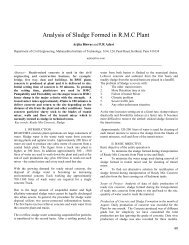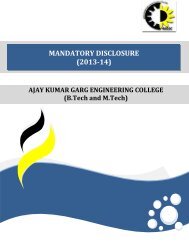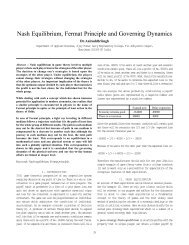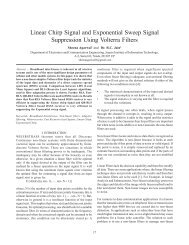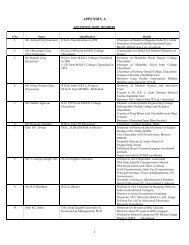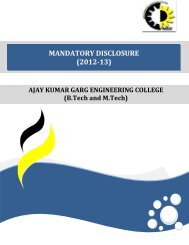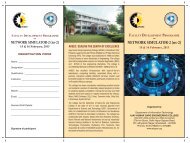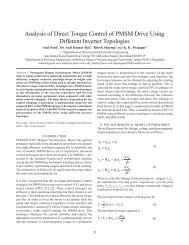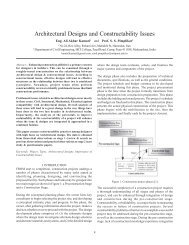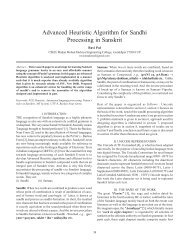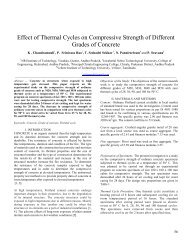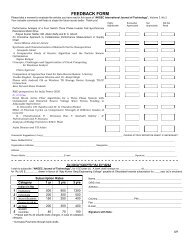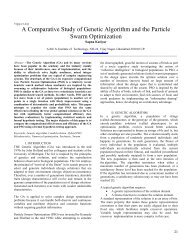Pdf Version - Ajay Kumar Garg Engineering College
Pdf Version - Ajay Kumar Garg Engineering College
Pdf Version - Ajay Kumar Garg Engineering College
You also want an ePaper? Increase the reach of your titles
YUMPU automatically turns print PDFs into web optimized ePapers that Google loves.
About the <strong>College</strong><br />
<strong>Ajay</strong> <strong>Kumar</strong> <strong>Garg</strong> <strong>Engineering</strong> <strong>College</strong>, Ghaziabad is affiliated to Mahamaya Technical University (MTU) and<br />
is approved by the All India Council for Technical Education. The <strong>College</strong> was<br />
established in 1998 and offers B.Tech. courses in six disciplines of<br />
<strong>Engineering</strong>. The college also offers postgraduate courses in Computer<br />
Application (MCA) and M.Tech. in Computer Science and <strong>Engineering</strong>,<br />
Automation & Robotics, Electronics and Communication <strong>Engineering</strong> and<br />
Electrical Power Energy Systems. The college strives for excellence and has<br />
the distinction of receiving Academic Excellence Award for Best <strong>Engineering</strong> <strong>College</strong> in UPTU consecutively<br />
for two years.<br />
The college has the distinction of being the only <strong>Engineering</strong> <strong>College</strong> in the state of Uttar Pradesh to have<br />
received approval from Deptt. of Science & Technology, Government of India, for establishment of Centre of<br />
Relevance and Excellence (CORE) in the field of Automation & Robotics under the mission REACH of TIFAC.<br />
The college has also established India's first industrial robotics training centre in collaboration with Kuka<br />
Robotics to train the students & technical manpower in advance robotics technologies.<br />
Why Functioanl Programming matters<br />
As software becomes more and more complex, it is more and more important to structure it well. Wellstructured<br />
software is easy to write, easy to debug, and provides a collection of modules that can be re-used to<br />
reduce future programming costs. Conventional languages place conceptual limits on the way problems can<br />
be modularized. Functional languages push those limits back.<br />
Functional programming is very different from imperative programming. The most significant differences<br />
stem from the fact that functional programming avoids side effects, which are used in imperative<br />
programming to implement state and I/O. Pure functional programming disallows side effects completely<br />
and so provides referential transparency, which makes it easier to verify, optimize, and parallelize programs,<br />
and easier to write automated tools to perform those tasks.<br />
To assist modular programming, a language must provide good glue. Functional programming languages<br />
provide two new kinds of glue - higher-order functions and lazy evaluation. Using these glues one can<br />
modularize programs in new and exciting ways.<br />
PROGRAMMING<br />
IMPERATIVE<br />
Functional programming has long been popular in academia, but with few industrial applications. However,<br />
recently several prominent functional programming languages have been used in commercial or industrial<br />
systems. For example, the Erlang programming language, which was developed by the Swedish company<br />
Ericsson in the late 1980s, was originally used to implement fault-tolerant telecommunications systems. It has<br />
since become popular for building a range of applications at companies such as T-Mobile, Nortel, Facebook<br />
and EDF. The Scheme dialect of Lisp was used as the basis for several applications on early Apple Macintosh<br />
computers, and has more recently been applied to problems such as training simulation software and<br />
telescope control. Objective Caml, which was introduced in the mid 1990s, has seen commercial use in areas<br />
such as financial analysis, driver verification, industrial robot programming, and static analysis of embedded<br />
software. Haskell, although initially intended as a research language, has also been applied by a range of<br />
companies, in areas such as aerospace systems, hardware design, and web programming. Other functional<br />
programming languages that have seen use in industry include Scala, F#, Lisp, Standard ML, and Clojure.<br />
DECLARATIVE<br />
PROCEDURAL<br />
E.G. FORTRAN,C<br />
OBJECT ORIENTED<br />
E.G. C++,JAVA<br />
LOGIC<br />
E.G. PROLOG<br />
FUNCTIONAL<br />
E.G. HASKELL, ERLANG<br />
This FDP is an attempt to demonstrate to the “ real world ” that functional programming is vitally important,<br />
and also to help functional programmers exploit its advantages to the full by making it clear what those<br />
advantages are.



